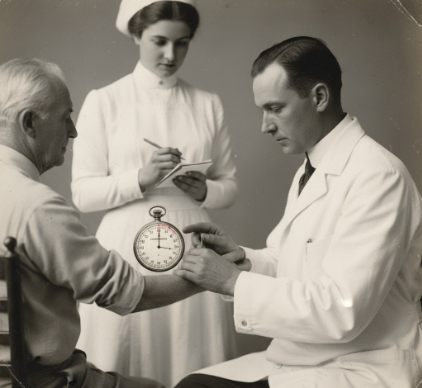Long before the advent of beeping electronic monitors and digital readouts, the simple act of taking a patient’s pulse was a cornerstone of medical diagnosis. It was an intimate, tactile process, relying on the sensitivity of a physician’s fingertips and the steady rhythm of their own internal clock or a glance at a pocket watch. This method, while effective for centuries, was inherently subjective and required calculation. However, the turn of the 20th century saw the rise of a wonderfully ingenious tool that blended the precision of horology with the practical needs of medicine: the pulsometer chronograph. This specialized timepiece was not merely a watch; it was a dedicated diagnostic instrument designed for one specific, crucial task, to measure the human heart rate quickly and accurately.
The Challenge of Quantifying the Pulse
For millennia, physicians understood the heart’s rhythm as a vital sign. From the ancient Egyptians to the Greek physician Galen, the characteristics of the pulse, its speed, strength, and regularity, provided clues to a patient’s health. Yet, quantifying this rhythm was a persistent challenge. Early attempts were cumbersome, such as Galileo’s friend Santorio Santorio, who invented the ‘pulsilogium,’ a pendulum-based device to time the pulse. While innovative, these tools were impractical for a doctor making rounds. For most, the standard method involved counting the beats over a full minute, a time-consuming process in a busy ward, or counting for 15 seconds and multiplying by four, which introduced potential for error and required mental arithmetic amidst the pressures of patient care.
The solution would not come from the world of medicine, but from the world of precision timekeeping. The development of the chronograph in the 19th century, a watch with a stopwatch function, revolutionized the measurement of short intervals. Initially prized in fields like horse racing and artillery, its potential for scientific and medical application was undeniable. It offered a way to capture a slice of time with unprecedented accuracy, setting the stage for a new kind of medical tool.
The Birth of a Specialized Scale
The pulsometer, also known as a pulsemeter, is essentially a specialized application of a tachymeter scale, which is used to measure speed. Instead of measuring distance over time, the pulsometer measures a fixed number of events (heartbeats) over time to calculate a rate (beats per minute). The genius lies in its logarithmic scale, printed on the watch’s dial or bezel. This scale is pre-calibrated, most commonly for 30 or sometimes 15 pulsations.
The pulsometer scale’s brilliance was its directness. By calibrating the chronograph for a set number of heartbeats, it removed the need for any mental calculation by the physician. A doctor could instantly read an accurate beats-per-minute rate from the dial, a significant advantage that saved time and reduced the chance of error during patient examinations.
The process for the medical professional was elegant in its simplicity. The doctor would place their fingers on the patient’s pulse point, typically the radial artery in the wrist. Simultaneously, they would press the chronograph’s pusher to start the sweeping second hand. They would then count the heartbeats. Upon reaching the predetermined number, for example, 30 beats, they would press the pusher again to stop the hand. The tip of the stopped second hand would now point directly to the patient’s heart rate on the pulsometer scale. If 30 beats took 25 seconds, the hand would point to 72, indicating a heart rate of 72 beats per minute. It was fast, efficient, and impressively accurate.
An Emblem of the Modern Physician
In the first half of the 20th century, from the 1920s through the 1950s, the pulsometer chronograph became a hallmark of the modern, scientifically-minded doctor. In an era where medicine was rapidly advancing, embracing technology and data, such a tool was more than just a convenience, it was a status symbol. It signaled a commitment to precision and efficiency. Watch manufacturers like Longines, Universal Genève, and Gallet became famous for producing these “doctor’s watches,” often featuring high-quality movements and clean, legible dials designed for quick reading. These were not just timepieces; they were instruments of a trade, as essential as a stethoscope or a thermometer.
Decline in the Face of Electronic Advancement
The reign of the mechanical pulsometer in the medical field was destined to be relatively short-lived. The post-war technological boom heralded the age of electronics, and medicine was one of the fields most profoundly transformed. The development of compact, battery-powered devices that could measure a patient’s vitals automatically began to emerge in the 1960s and 1970s. These new electronic monitors could provide continuous, real-time readings of a patient’s heart rate without any manual intervention from the doctor or nurse.
It is crucial to understand that while vintage and modern watches featuring a pulsometer scale are fascinating pieces of history, they are not considered medical devices by today’s standards. They should not be used for medical diagnosis or to monitor a health condition. Always rely on certified medical equipment and the advice of a qualified healthcare professional.
The convenience, accuracy, and continuous monitoring capability of these new electronic devices rendered the mechanical pulsometer clinically obsolete. The elegant, manual process of starting a chronograph and counting beats was replaced by the simple act of clipping a sensor to a patient’s finger. While the mechanical watch represented a huge leap forward from counting beats against a pocket watch, it could not compete with the sheer utility and data-rich output of electronic instrumentation.
Today, the pulsometer scale lives on primarily as a nostalgic feature on vintage-inspired timepieces. It is a cherished “complication” for watch enthusiasts, a nod to a time when a physician’s watch was a life-saving tool. It serves as a beautiful and functional reminder of a fascinating chapter in medical history, representing the perfect marriage of mechanical ingenuity and the timeless art of healing. It tells a story of the relentless human drive to measure, to quantify, and to better understand the vital rhythm of life itself.









